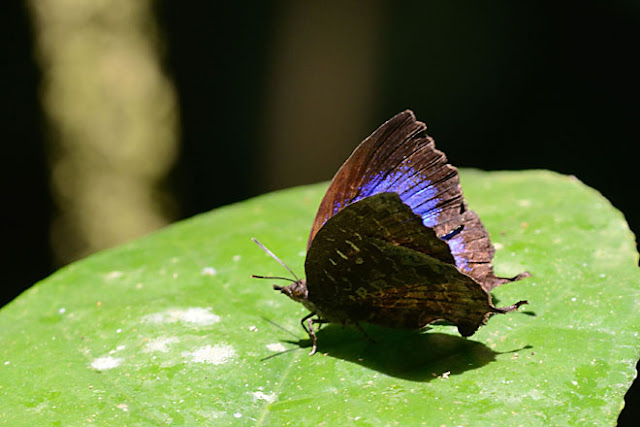This was what we saw at Stream 2 - you could see how they clustered themselves and enjoyed the puddling together. But this was really tough for us looking for an obstructed individual butterfly. So I decided to look for butterflies on leaves.
This small skipper is the Halpe porus, feeding on some bird droppings at the second stream.
Though there were many butterflies perching on leaves, somehow there were hyper sensitive to human movement. At last, I found this lethargic Lesser Gull (Cepora nadina nadina) taking a nap after an afternoon meal.
The Yellow Orange Tip (Ixias pyrene verna) was abundant - we could see then puddling and flying everywhere but again there were extremely sensitive to people - in fact I didn't have any good and clear chances of shooting them.
Of course we derived more excitement from shooting the puddling butterflies as we always hoped to find something rare hiding in the groups. The Marbled Map (Cyrestis cocles cocles) appeared to be "talking" to a Prosota.
With intense scanning of the ground, I managed to locate and shoot the underside of a Marbled Map which stayed slightly away from the puddling groups.
I also managed to find an isolated Orange Gull (Cepora iudith malaya) at a distance away from me.
While strolling from Stream 2 to Stream 3, we managed to shoot quite a number of pudding butterflies along the vehicle track. The Striped Swordtail (Graphium aristeus hermocrates) was new to me.
Next, a small orange skipper, Thoressa masoni also loved to puddle.The Common Gull (Cepora nerissa dapha) was a rather alert fellow, not giving me a chance to get parallel to the wings.
When we reached Stream 3, it wasn't as magnificent as what we witnessed at Stream 2. But this Lemon Emigrant (Catapsillia pomona pomona) got me interested as I didn't encounter the form-pomona frequently in Singapore.
We were on wheels again heading to a holding site for ascending to the mountain. Due to time constraint, we did not go further up. Mr Yano brought us to explore the forest from a side trail branching off from the main vehicle track. The Common Cornelian (Deudorix epijarbas epijarbas) was my first shot along this forest trail.
BJ spotted the Narrow Spark (Sinthusa nasaka amba) after quite a long distance of strolling along the damp forest trail.Not far away, there was this small skipper looking like a Halpe hauxwelli.
A shot of its uppersides should be useful for confirming the species.
The Spangle (Papilio protenor euproteno) was puddling on a small forest stream - I misidentified it as a Great Mormon- thanks Dr Seow from ButterflyCircle for correcting it.
We had to backtrack as we realised that we had been walking more than an hour on this no-man's land. We finally saw a "Arhopala" - all of us got very excited. But it turned out to be The Malayan Falcate Oakblue (Mahathala ariadeva ariadeva).
A glimpse of the upperside may be useful for confirming the identification.
While we were on our way back to the Birdcamp accommodation, our vehicle stopped at Stream 2 again. Though it was late afternoon there were still quite a number of puddling butterflies including a few Paris Peacocks (Papilio paris paris). This is a long distance shot of a pristine specimen.
Another Cornelian suddenly appeared in front of me and started puddling on a mud pool.
A lonely and tame Common Jester (Symbrenthia lilaea luciana) was found resting on a leaf when we walked across Stream 2.Suddenly it opened its wings widely.
There was a forest side trail at Stream 2 - we went in and were rewarded with our first Arhopala shot at KK Park. This is believed to beThe Zambra Oakblue (Arhopala zambra zambra) which was spotted by Mr Yano.
We continued to head back to the main gate. Along the way, we still saw many puddling butterflies on the vehicle track. This is The Common Yeoman (Cirrochroa tyche rotundata).A male Cruiser (Vindula dejone erotella) - in fact there were many of them.
There were just too many White-spot Beaks (Libythea narina rohini) clustering together on the ground - luckily this fellow deserted its group.
A male Plane (Bindahara phocides phocides) decided say good bye to us when we were moving towards the main gate.
Our vehicle finally reached the tarred road again - our last stop of the day. We saw a large long-tailed lycaenid flitting around. We waited a while to get a few shots of this pristine and elegant Common Imperial (Cheritra freja evansi).
It was a very fruitful first day shooting at the KK Park. After a quick rest in our room, we had a good dinner at the "canteen". All of a sudden, someone recognised me and called out my name - what a big big surprise !! Who was this person ?


.jpg)

.jpg)

.jpg)
.jpg)

.jpg)

.jpg)

.jpg)
.jpg)





.jpg)


.jpg)
.jpg)
.jpg)
.jpg)
.jpg)
No comments:
Post a Comment